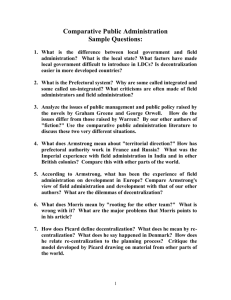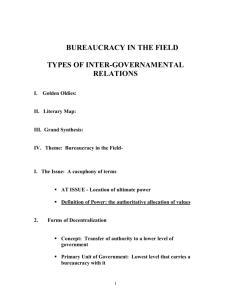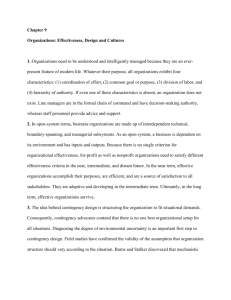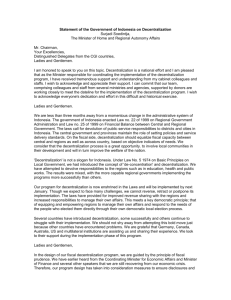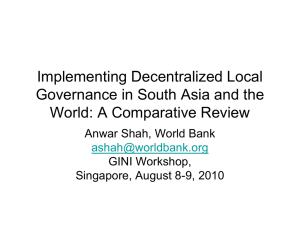Centralization, Decentralization & Shared Services Literature Review
advertisement
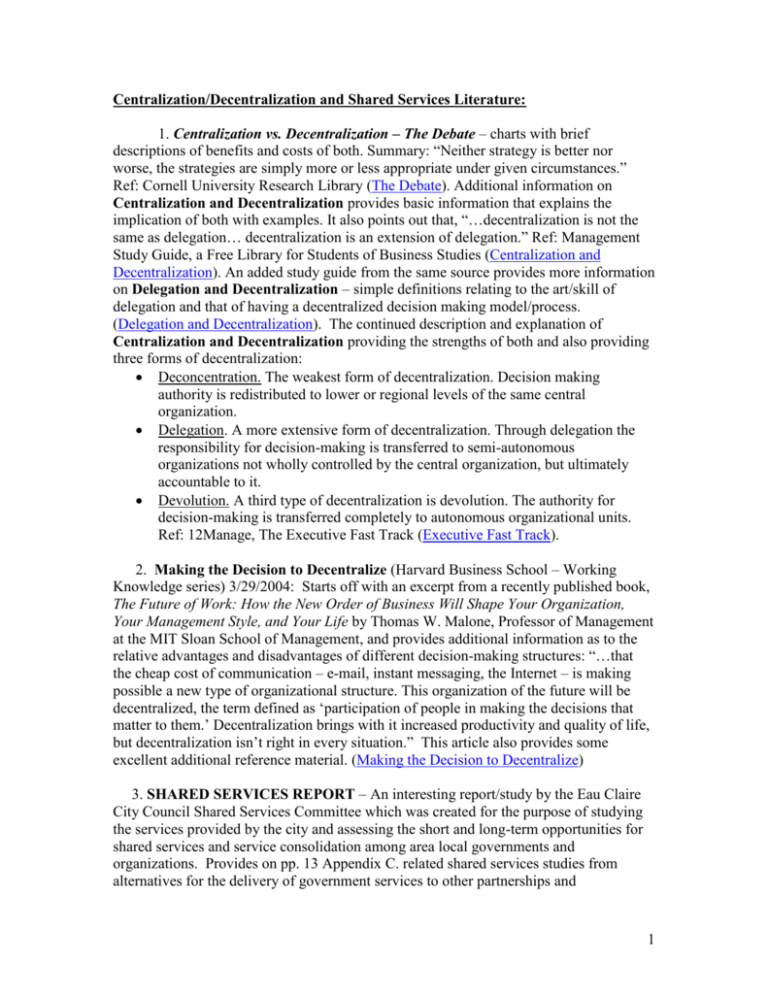
Centralization/Decentralization and Shared Services Literature: 1. Centralization vs. Decentralization – The Debate – charts with brief descriptions of benefits and costs of both. Summary: “Neither strategy is better nor worse, the strategies are simply more or less appropriate under given circumstances.” Ref: Cornell University Research Library (The Debate). Additional information on Centralization and Decentralization provides basic information that explains the implication of both with examples. It also points out that, “…decentralization is not the same as delegation… decentralization is an extension of delegation.” Ref: Management Study Guide, a Free Library for Students of Business Studies (Centralization and Decentralization). An added study guide from the same source provides more information on Delegation and Decentralization – simple definitions relating to the art/skill of delegation and that of having a decentralized decision making model/process. (Delegation and Decentralization). The continued description and explanation of Centralization and Decentralization providing the strengths of both and also providing three forms of decentralization: Deconcentration. The weakest form of decentralization. Decision making authority is redistributed to lower or regional levels of the same central organization. Delegation. A more extensive form of decentralization. Through delegation the responsibility for decision-making is transferred to semi-autonomous organizations not wholly controlled by the central organization, but ultimately accountable to it. Devolution. A third type of decentralization is devolution. The authority for decision-making is transferred completely to autonomous organizational units. Ref: 12Manage, The Executive Fast Track (Executive Fast Track). 2. Making the Decision to Decentralize (Harvard Business School – Working Knowledge series) 3/29/2004: Starts off with an excerpt from a recently published book, The Future of Work: How the New Order of Business Will Shape Your Organization, Your Management Style, and Your Life by Thomas W. Malone, Professor of Management at the MIT Sloan School of Management, and provides additional information as to the relative advantages and disadvantages of different decision-making structures: “…that the cheap cost of communication – e-mail, instant messaging, the Internet – is making possible a new type of organizational structure. This organization of the future will be decentralized, the term defined as ‘participation of people in making the decisions that matter to them.’ Decentralization brings with it increased productivity and quality of life, but decentralization isn’t right in every situation.” This article also provides some excellent additional reference material. (Making the Decision to Decentralize) 3. SHARED SERVICES REPORT – An interesting report/study by the Eau Claire City Council Shared Services Committee which was created for the purpose of studying the services provided by the city and assessing the short and long-term opportunities for shared services and service consolidation among area local governments and organizations. Provides on pp. 13 Appendix C. related shared services studies from alternatives for the delivery of government services to other partnerships and 1 collaboration efforts and in Appendix D provides summary of some of the city shared services strategies. (Shared Services Report) 4. FLATTENING ORGANIZATIONS: PRACTICES AND STANDARDS, California Research Bureau, California State Library CRB 97-004 (September 1997), examines public and private organizational structures, including management/rank and file ratios (span of control), the factors that underlie optimum standards, incentives that foster enhanced performance, and the success or failure of recent efforts to restructure operations. It provides information on California departments and commissions relating to span of control and the efforts in “flattening” organizations. Also provides an excellent bibliography. (Flattening Organizations) 5. DRIVING HIGH PERFORMANCE IN GOVERNMENT: MAXIMIZING THE VALUE OF PUBLIC-SECTOR SHARED SERVICES (Accenture, January 2005). In this article, Accenture aims to show how the drive toward high-performance government can be supported through implementing shared services. Shared services help governments be more client-centered, outcome-oriented and accountable, by allowing governments to focus on their core responsibilities and to operate more efficiently.* Ultimately, shared services can increase public-sector value—the return government gets on its investments—by decreasing administrative costs by up to 25 percent and freeing up human resources to be redirected to citizen facing front-office programs. When used correctly, shared services can be an engine of high performance, delivering significant cost reductions and dramatic service improvements, both of which result in improved value. Article describes Methodology, Four Key Findings and Leading practices of the innovators. (Driving High Performance in Government) A footnote in the forward of the report may say it all: “Accenture research suggests that high performers in the public sector base the value they create on two criteria: the outcomes they deliver for citizens and the cost-effectiveness they achieve. By focusing on both outcomes and cost-effectiveness, high performance government organizations strive not only to do the right things, but also to do them in the right way”. Pp 2 * 2



